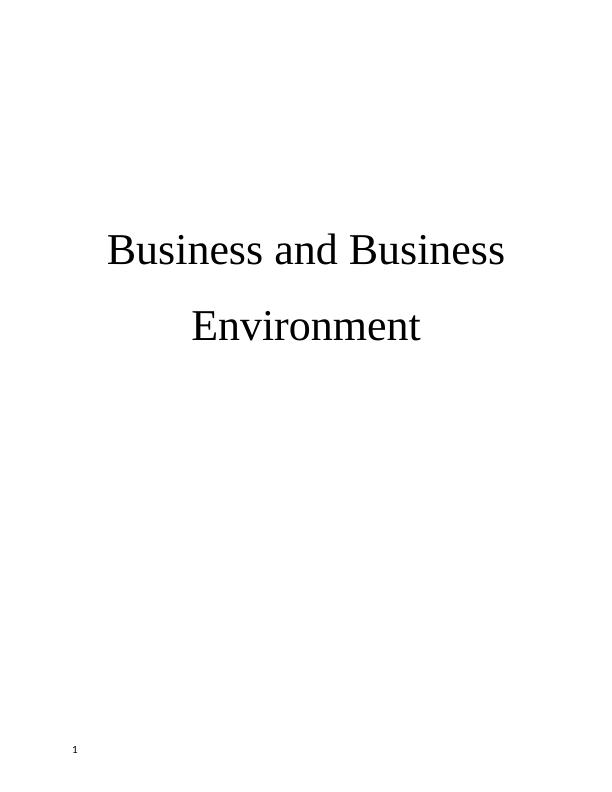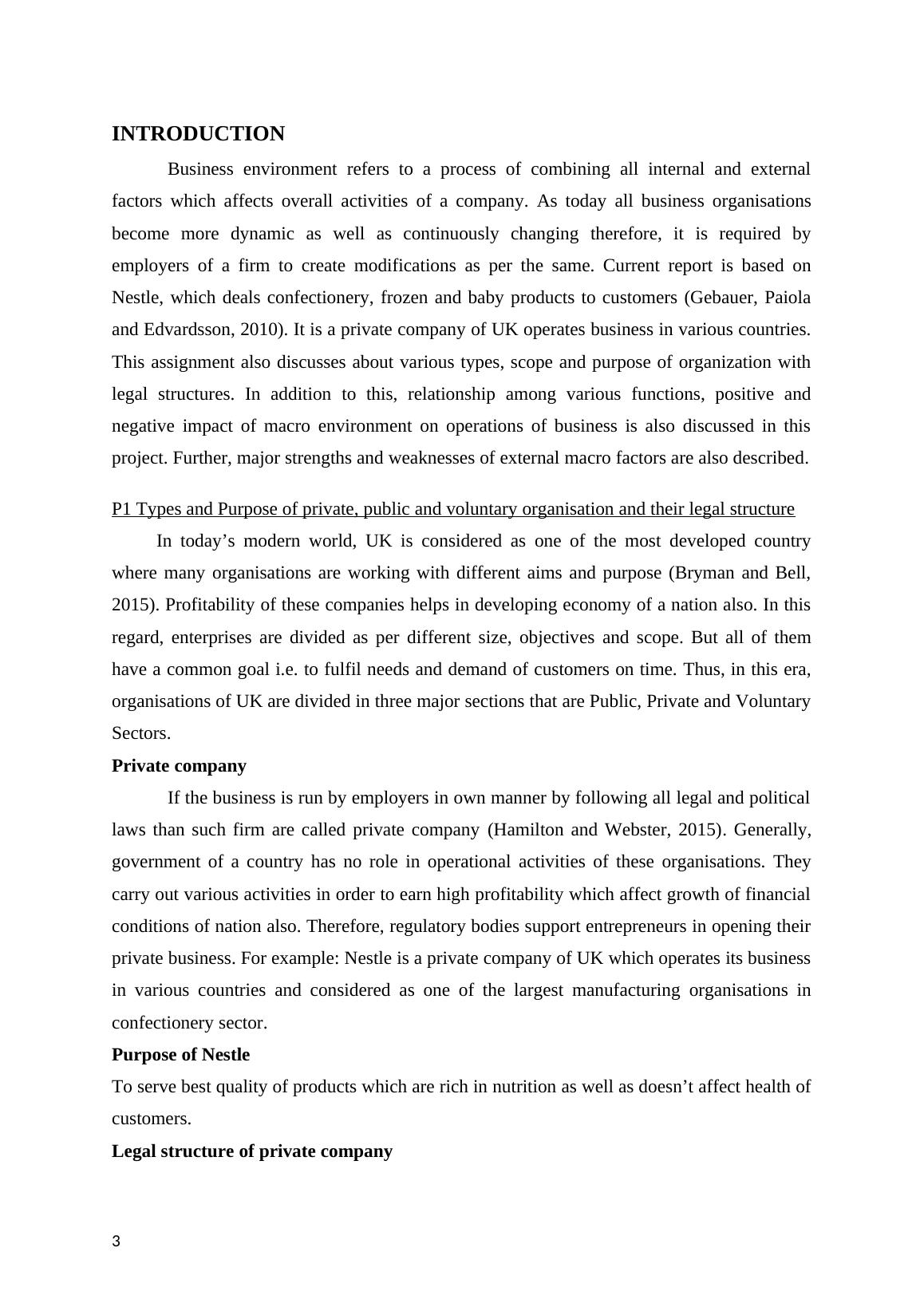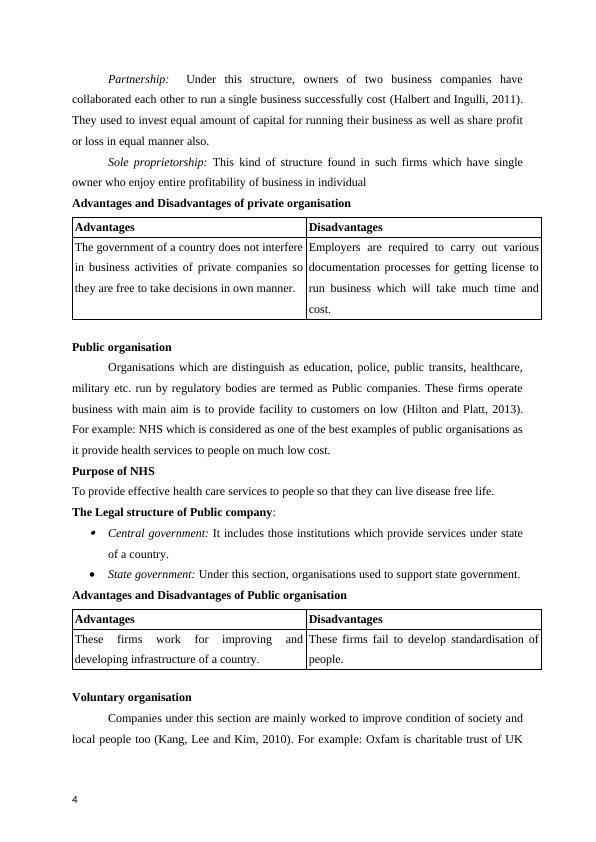Business and Business Environment Assignment - Nestle
14 Pages4689 Words289 Views
Added on 2020-10-05
Business and Business Environment Assignment - Nestle
Added on 2020-10-05
ShareRelated Documents
Business and BusinessEnvironment1

Table of ContentsP1 Types and Purpose of private, public and voluntary organisation and their legal structure.........3P2 Size and Scope of various types of organisations.........................................................................5P3 Relationship between different organizational functions and how they link to organizational objectives and structure....................................................................................................................6P4 Impact of macro-environmental factors on business of an organisation......................................8P5 Internal analysis of organisation for identification of strength and weaknesses .......................10P6 Interrelation of macro-environmental factors with organisational strength and weaknesses...112

INTRODUCTIONBusiness environment refers to a process of combining all internal and externalfactors which affects overall activities of a company. As today all business organisationsbecome more dynamic as well as continuously changing therefore, it is required byemployers of a firm to create modifications as per the same. Current report is based onNestle, which deals confectionery, frozen and baby products to customers (Gebauer, Paiolaand Edvardsson, 2010). It is a private company of UK operates business in various countries.This assignment also discusses about various types, scope and purpose of organization withlegal structures. In addition to this, relationship among various functions, positive andnegative impact of macro environment on operations of business is also discussed in thisproject. Further, major strengths and weaknesses of external macro factors are also described.P1 Types and Purpose of private, public and voluntary organisation and their legal structureIn today’s modern world, UK is considered as one of the most developed countrywhere many organisations are working with different aims and purpose (Bryman and Bell,2015). Profitability of these companies helps in developing economy of a nation also. In thisregard, enterprises are divided as per different size, objectives and scope. But all of themhave a common goal i.e. to fulfil needs and demand of customers on time. Thus, in this era,organisations of UK are divided in three major sections that are Public, Private and VoluntarySectors. Private companyIf the business is run by employers in own manner by following all legal and politicallaws than such firm are called private company (Hamilton and Webster, 2015). Generally,government of a country has no role in operational activities of these organisations. Theycarry out various activities in order to earn high profitability which affect growth of financialconditions of nation also. Therefore, regulatory bodies support entrepreneurs in opening theirprivate business. For example: Nestle is a private company of UK which operates its businessin various countries and considered as one of the largest manufacturing organisations inconfectionery sector. Purpose of NestleTo serve best quality of products which are rich in nutrition as well as doesn’t affect health ofcustomers.Legal structure of private company3

Partnership: Under this structure, owners of two business companies havecollaborated each other to run a single business successfully cost (Halbert and Ingulli, 2011).They used to invest equal amount of capital for running their business as well as share profitor loss in equal manner also. Sole proprietorship: This kind of structure found in such firms which have singleowner who enjoy entire profitability of business in individual Advantages and Disadvantages of private organisationAdvantagesDisadvantagesThe government of a country does not interferein business activities of private companies sothey are free to take decisions in own manner. Employers are required to carry out variousdocumentation processes for getting license torun business which will take much time andcost.Public organisationOrganisations which are distinguish as education, police, public transits, healthcare,military etc. run by regulatory bodies are termed as Public companies. These firms operatebusiness with main aim is to provide facility to customers on low (Hilton and Platt, 2013).For example: NHS which is considered as one of the best examples of public organisations asit provide health services to people on much low cost.Purpose of NHSTo provide effective health care services to people so that they can live disease free life. The Legal structure of Public company:Central government: It includes those institutions which provide services under stateof a country.State government: Under this section, organisations used to support state government.Advantages and Disadvantages of Public organisationAdvantagesDisadvantagesThese firms work for improving anddeveloping infrastructure of a country.These firms fail to develop standardisation ofpeople. Voluntary organisationCompanies under this section are mainly worked to improve condition of society andlocal people too (Kang, Lee and Kim, 2010). For example: Oxfam is charitable trust of UK4

End of preview
Want to access all the pages? Upload your documents or become a member.
Related Documents
Nestle Business & Business Environmentlg...
|13
|4023
|281
(Solution) Nestle Business Environmentlg...
|19
|5115
|213
Report on Business and Business Environment of Nestle companylg...
|15
|4921
|87
SWOT and PESTLE Analysis of Nestlelg...
|17
|5241
|98
Business and Business Environment of Nestlelg...
|16
|4997
|403
Business Environment Assignment : Nestle firmlg...
|16
|4931
|145
